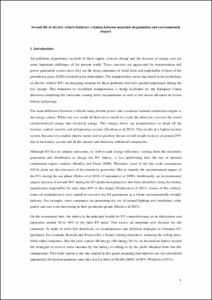Mostra el registre d'ítem simple
Second life of electric vehicle batteries: relation between materials degradation and environmental impact
| dc.contributor.author | Canals Casals, Lluc |
| dc.contributor.author | Amante García, Beatriz |
| dc.contributor.author | Aguesse, Frédéric |
| dc.contributor.author | Iturrondobeitia, Amaia |
| dc.contributor.other | Universitat Politècnica de Catalunya. Departament d'Enginyeria de Projectes i de la Construcció |
| dc.date.accessioned | 2015-11-11T19:25:44Z |
| dc.date.available | 2017-12-20T01:30:14Z |
| dc.date.issued | 2015-06-30 |
| dc.identifier.citation | Canals, L., Amante, B., Aguesse, F., Iturrondobeitia, A. Second life of electric vehicle batteries: relation between materials degradation and environmental impact. "International journal of life cycle assessment", 09 Novembre 2015. |
| dc.identifier.issn | 0948-3349 |
| dc.identifier.uri | http://hdl.handle.net/2117/79078 |
| dc.description.abstract | Nowadays, the electric vehicle is one of the most promising alternatives for sustainable transportation. However, the battery, which is one of the most important components, is the main contributor to environmental impact and faces recycling issues. In order to reduce the carbon footprint and to minimize the overall recycling processes, this paper introduces the concept of re-use of electric vehicle batteries, analyzing some possible second-life applications. Methods First, the boundaries of the life cycle assessment of an electric vehicle are defined, considering the use of the battery in a second-life application. To perform the study, we present eight different scenarios for the second-life application. For each case, the energy, the efficiency, and the lifetime of the battery are calculated. Additionally, and based on the global warming potential, the environmental impact of the electric vehicle and its battery on a second-life application is determined for each scenario. Finally, an environmentally focused discussion on battery electrodes and research trends is presented. Results and discussion For the selected scenarios, the second life of the battery varies from 8 to 20 years depending on the application and the requirements. It has been observed that the batteries connected to the electricity grid for energy arbitrage storage have the highest impact per provided kilowatt hour. On the contrary, the environmental benefit comes from applications working with renewable energy sources and presenting a longer lifetime. We pointed out that a correlation between cycling conditions and degradation mechanisms of the electrode materials is compulsory for proper use of the electric vehicle battery in a second-life application. Conclusions To limit the environmental impact, batteries should be associated with renewable energy sources in stationary applications. However, it is more profitable to re-use Li-ion batteries than to use new lead-acid batteries. Although many batteries applied for electric vehicles use graphite-based anodes, the latter may not be the most suitable for the second-life application. A better understanding of Li-ion battery degradation during the second-life application is required for the different existing chemistries. |
| dc.language.iso | eng |
| dc.rights.uri | http://creativecommons.org/licenses/by-nc-nd/3.0/es/ |
| dc.subject | Àrees temàtiques de la UPC::Enginyeria mecànica::Motors::Motors elèctrics |
| dc.subject | Àrees temàtiques de la UPC::Energies::Tecnologia energètica |
| dc.subject.lcsh | Lithium ion batteries |
| dc.subject.lcsh | Electric vehicles -- Batteries |
| dc.subject.other | Degradation mechanisms |
| dc.subject.other | Electric vehicle |
| dc.subject.other | Environmental cost |
| dc.subject.other | Li-ion battery |
| dc.subject.other | Second life |
| dc.title | Second life of electric vehicle batteries: relation between materials degradation and environmental impact |
| dc.type | Article |
| dc.subject.lemac | Bateries d'ió liti |
| dc.subject.lemac | Vehicles elèctrics -- Bateries |
| dc.contributor.group | Universitat Politècnica de Catalunya. GIIP - Grup de Recerca en Enginyeria de Projectes: Disseny i Sostenibilitat |
| dc.identifier.doi | 10.1007/s11367-015-0918-3 |
| dc.relation.publisherversion | http://link.springer.com/article/10.1007/s11367-015-0918-3 |
| dc.rights.access | Open Access |
| local.identifier.drac | 16271623 |
| dc.description.version | Postprint (author's final draft) |
| local.citation.author | Canals, L.; Amante, B.; Aguesse, F.; Iturrondobeitia, A. |
| local.citation.publicationName | International journal of life cycle assessment |
Fitxers d'aquest items
Aquest ítem apareix a les col·leccions següents
-
Articles de revista [360]
-
Articles de revista [142]


